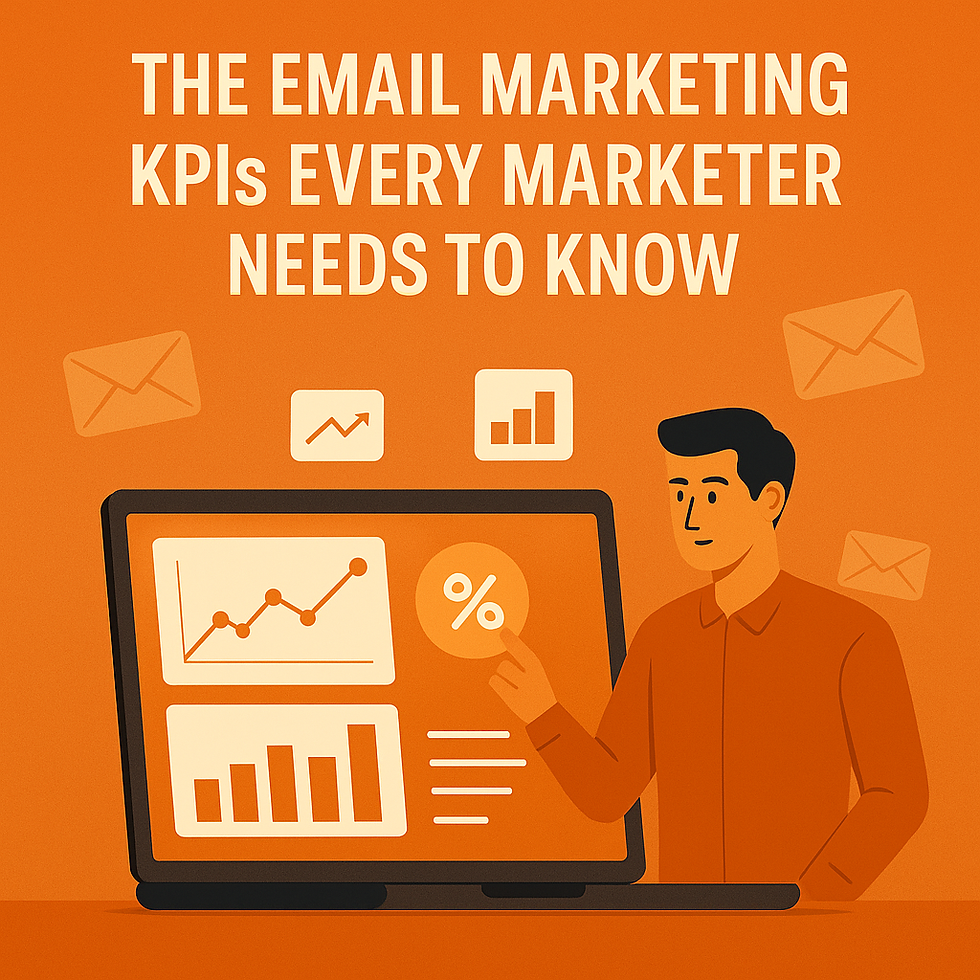The Email Marketing KPIs Every Marketer Needs to Know
- Papaya Marketing
- 25 oct 2024
- 3 Min. de lectura

Email marketing isn’t just about crafting beautiful emails. To drive real results, you need to measure what matters. That’s where KPIs—Key Performance Indicators—come into play. These are the metrics that show whether your strategy is working (or not).
Without understanding and tracking these KPIs, you’re essentially flying blind. You could be sending out hundreds—or thousands—of emails and have no clue if they’re actually helping your bottom line. The right KPIs allow you to tweak and improve your campaigns for maximum efficiency and ROI.
Here are 10 essential email marketing KPIs every ecommerce marketer should be tracking: 1. Deliverability Rate: This measures how many of your emails actually reach your subscribers’ inboxes. If you're landing in spam, your open rate will tank—regardless of how great your subject line is.
How to measure: (Total Emails Sent - Bounced Emails) / Total Emails Sent
Why it matters: If your emails don’t land, they can’t perform. Deliverability is the foundational metric. It reflects your sender reputation and hygiene. Think of it like the quality of the soil before planting seeds—if it’s no good, nothing grows. 2. Open Rate: The percentage of people who open your email. It's the first layer of engagement and gives you insights into subject line effectiveness and audience curiosity.
How to measure: (Unique Opens / Emails Delivered) x 100
Why it matters: A low open rate can signal issues with your subject lines, send time, or sender reputation. A good benchmark for ecommerce? 35%–40% or higher. 3. Click Rate (CTR): This measures how many recipients clicked on a link inside your email. It helps you understand how engaging your content really is.
How to measure: (Unique Clicks / Emails Delivered) x 100
Why it matters: Click rate reflects content relevance. High CTR = your message is aligned with what your readers care about. 4. Click-to-Open Rate (CTOR): Tells you how effective your email content is after someone opens it. It’s a measure of how compelling your offer or CTA is.
How to measure: (Unique Clicks / Unique Opens) x 100
Why it matters: Even if someone opens your email, they might bounce if the message doesn’t resonate. CTOR helps you optimize your layout, copy, and CTAs. 5. Unsubscribe Rate: Tracks how many people opted out after receiving your email.
Why it matters: A sudden increase might mean you’re sending too often, targeting the wrong people, or delivering irrelevant content. Always balance growth with retention. Monitor this metric closely after major sends or when testing new content types. 6. Bounce Rate: The percentage of emails that couldn’t be delivered.
How to measure: (Total Bounced Emails / Total Sent) x 100
Why it matters: Too many bounces damage your sender score. This often comes from outdated lists or poor collection methods. Regular list cleaning is essential. Also, distinguish between hard and soft bounces to understand if the issue is temporary or permanent. 7. Spam Complaint Rate: How many recipients marked your email as spam.
Why it matters: This is critical. Too many complaints and inbox providers will send you straight to spam—even for people who want to hear from you. Keep content relevant, always include a clear unsubscribe option, and respect frequency preferences. 8. Revenue Per Recipient (RPR): Measures how much money you're generating per subscriber.
How to measure: Total Revenue from Campaign / Number of Recipients
Why it matters: This KPI ties your email performance directly to revenue. It’s ideal for tracking ROI over time. Segment your audience and compare RPR across groups to understand who your high-value subscribers are. 9. List Growth Rate: Are you gaining or losing subscribers?
How to measure: [(New Subscribers - Unsubscribers) / Total Subscribers] x 100
Why it matters: List fatigue is real. If your list is shrinking or stagnant, it’s a sign to revamp acquisition or re-engagement strategies. Focus on quality over quantity—grow with engaged, interested leads. 10. Conversion Rate: The percentage of recipients who took a desired action (e.g., purchased).
How to measure: (Conversions / Emails Delivered) x 100
Why it matters: Ultimately, it’s not just about opens or clicks—it’s about what people do next. This is your north star. You want your email marketing efforts to translate into actual revenue or specific actions like signups or bookings. Tracking KPIs isn’t just about numbers—it’s about understanding your audience, improving performance, and growing revenue. When you combine smart strategy with data-driven decisions, your email program becomes one of the most powerful revenue-generating assets in your ecommerce toolbox.
Stay tuned—more expert blog posts coming soon on everything from email deliverability to automated flows and why Klaviyo continues to lead the pack.




Comentarios